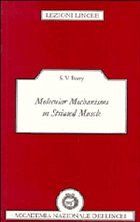Striated muscle is the most common muscle type in the vertebrate body. This book describes in molecular terms the components and intracellular events responsible for the contraction and relaxation of striated muscle. The topic is introduced with a discussion of motile systems occurring throughout the biological world and their relation to the highly specialised contractile system of muscle. Professor Perry then goes on to discuss the mechanochemical process and the regulatory roles of calcium, I filament proteins and phosphorylation. The book ends with an examination of the role of dystrophin and its implications in Duchenne muscular dystrophy, the most common form of muscle disease. Molecular Mechanisms in Striated Muscle will provide an important source of information and current theory for researchers and postgraduate students in muscle physiology, biochemistry and medicine.
Table of contents:
1. General aspects of motile systems; 2. Mechanochemistry of contraction; 3. Calcium and the regulation of contraction; 4. I filament regulation; 5. Regulation of muscle function by phosphorylation; 6. Dystrophin and the muscular dystrophies.
Striated or skeletal muscle is both highly specialised and very common in the vertebrate body. In this book, Professor Perry discusses and evaluates the great strides that have been taken recently to further our understanding of the molecular mechanisms and regulatory processes in both normal and diseased muscle.
Definitive publication on the molecular mechanisms of striated muscle.
Table of contents:
1. General aspects of motile systems; 2. Mechanochemistry of contraction; 3. Calcium and the regulation of contraction; 4. I filament regulation; 5. Regulation of muscle function by phosphorylation; 6. Dystrophin and the muscular dystrophies.
Striated or skeletal muscle is both highly specialised and very common in the vertebrate body. In this book, Professor Perry discusses and evaluates the great strides that have been taken recently to further our understanding of the molecular mechanisms and regulatory processes in both normal and diseased muscle.
Definitive publication on the molecular mechanisms of striated muscle.
